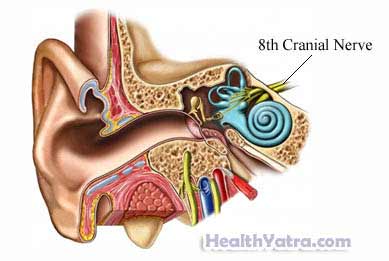تعريف
A cochlear implant is an electronic device that is implanted during surgery. It helps provide hearing to people who have a certain type of hearing loss. This type of hearing loss is usually caused by damage or a defect in the inner ear. The implants can directly stimulate the auditory nerve to send information to the brain.
Cochlear implants have three parts:
- Speech processor—The speech processor looks like a long, narrow calculator. It is worn behind the ear or on a belt. It increases sound, converts it into digital signals, and sends these signals to the transmitter.
- Transmitter—The transmitter is a headphone that is worn behind the ear. It receives electrical signals from the speech processor and sends them through the skin to the receiver.
- Receiver—The receiver is the part that is implanted. It is a magnetic disk about the size of a quarter. It is placed under the skin behind one ear. A wire that runs from the receiver to an electrode is placed in the inner ear, where it stimulates the acoustic nerve.

أسباب هذا الإجراء
Cochlear implants provide a heightened sense of sound for adults and children with profound hearing loss. They are designed for people whose hearing does not improve with surgical correction or the use of a hearing aid. Cochlear implants will not restore or create normal hearing.
المضاعفات المحتملة
If you are planning to have an implant, your سيقوم الطبيب بمراجعة القائمة من المضاعفات المحتملة، والتي قد تشمل:
- العدوى
- Damage to nearby nerves
- Problems with balance
- Emotional stress caused by having higher expectations for the technology
- Poor quality of hearing following the surgery
بعض العوامل التي قد تزيد من خطر المضاعفات تشمل:
- التدخين
- الجراحة السابقة
- Previous ear infections
- Abnormal anatomy
ما يمكن توقعه
قبل الإجراء
Your doctor may do some or all of the following.
- Your doctor will examine you, paying particular attention to your ears. This can be done with:
- A medical history and physical exam
- Ear exam
- Hearing evaluation
- Psychological evaluation
- Your doctor may need pictures of your ear. This can be done with:
- التصوير بالرنين المغناطيسي
- الاشعة المقطعية
- You should be up-to-date on immunizations. Pneumococcal, meningococcal, andhaemophilus vaccines are especially important. There has been a link between cochlear implants and bacterial meningitis.
المؤدية إلى الإجراء الخاص بك:
- التحدث مع طبيبك عن الأدوية الخاصة بك. قد يطلب منك التوقف عن تناول بعض الأدوية تصل إلى أسبوع واحد قبل العملية مثل:
- الأسبرين أو غيره من العقاقير المضادة للالتهابات
- مميعات الدم ، مثل كلوبيدوجريل أو وارفارين
- للترتيب من الإجراء.
- في الليلة السابقة، تناول وجبة خفيفة. لا تأكل أو تشرب أي شيء بعد منتصف الليل.
التخدير
General anesthesia is used for this procedure. You will be asleep.
الوصف الداخلي
There are two parts to the procedure:
- Implantation of receiver—A cut will be made in the skin behind the ear. A hole will be drilled through the bone behind the ear to the cochlea. A wire will be placed through the hole and into the cochlea. The receiver will then be put against the bone behind your ear. The wire will be attached to the receiver. The incision will be closed with stitches.
- External hook-up—In 4 to 6 weeks, the area should be healed. At this point, the transmitter headpiece and speech processor will be hooked up.
كم من الوقت سيستغرق ؟
About 1½-2 hours for adults and up to five hours for children
كم هو مؤلم ؟
Anesthesia prevents pain during the procedure. You will have some pain after. Your doctor can give you medicine to help manage any pain.
متوسط الإقامة في المستشفى
The length of stay depends on the reasons why you are having the implant. Speak to your doctor about how long your stay may be.
رعاية ما بعد العملية
في البيت
After your procedure, be sure to follow your doctor’s instructions. Ask your doctor about when it is safe to shower, bathe, or soak in water.
You will have frequent follow-up visits for the following:
- Headpiece fitting, done 4-6 weeks after surgery
- Adjustments to the speech processor
- Ongoing evaluation of hearing status
In addition, you will have cochlear implant training. This will help improve your ability to:
- Identify sounds
- Read lips
- Develop speech skills
استدعاء الطبيب
بعد مغادرة المستشفى، اتصل بطبيبك في حالة حدوث أي مما يلي:
- الألم
- Dizziness or vomiting
- Facial paralysis or twitching
- علامات الإصابة, بما في ذلك حمى وقشعريرة
- احمرار، تورم، زيادة الألم، نزيف مفرط، أو إفرازات في موقع الشق
- Cough, shortness or breath, chest pain, or severe nausea or vomiting
في حالة الطوارئ ، اتصل على المساعدة الطبية على الفور.
